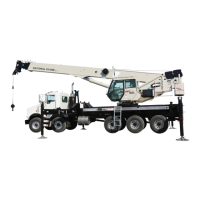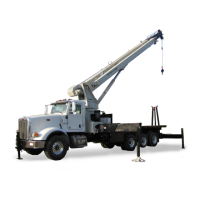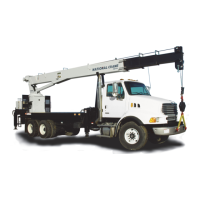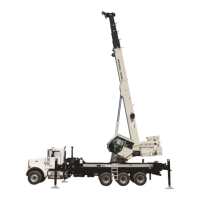National Crane 3-29-2018 Control # 610-00 2-31
NBT40-1 SERIES OPERATOR MANUAL SAFETY INFORMATION
Do not use the dead end lug on the boom nose for tying
down the boom during transport. Damage to the lug and
boom can result from usage as a tie down point.
Before transporting the equipment on a road or highway, first
check state and local restrictions and regulations.
Either the hook block may be reeved over the main boom
nose or the headache ball may be reeved over the main
boom nose or auxiliary boom nose; the other must be
removed. If the hook block or headache ball remains reeved
on the boom, it must be secured at the tie down on the carrier
to prevent swinging.
When using hookblock tie downs, excessive loading can be
applied by pulling the rope too tight, particularly when reeved
with multiple part lines. When the rope is hooked into the
hookblock tie down, the rope should be merely “snugged-up”
with adequate slack provided at the center line of sheave to
anchor point and avoid contact with surrounding
components. Do not draw rope taut. Care must be exercised
anytime any equipment function is being performed while the
rope is hooked into the hookblock tie down.
TRAVEL OPERATION
Only the equipment operator shall occupy the equipment
when traveling.
When traveling, the boom should be completely retracted
and lowered to the travel position. If equipped with boom
rest, lower the boom into the boom rest and engage the
turntable swing lock pin and/or 360 degree swing lock (if
equipped).
Strictly adhere to the guidelines and restrictions in the Load
Chart for operations.
Traveling at high speeds, especially on rough ground, may
create a bouncing effect that can result in loss of control. If
bouncing occurs, reduce travel speed.
Death or serious injury could result from being crushed by
revolving tires.
Stunt driving and horse-play are strictly prohibited. Never
allow anyone to hitch a ride or get on or off a moving
equipment.
Follow the instructions in this manual when preparing the
equipment for travel.
If using a boom dolly/trailer, thoroughly read and understand
all the steps and safety precautions in this manual for setup
and travel.
When driving the equipment, ensure the cab is level, if
equipped with a tilting cab.
Secure the hook block and other items before moving the
equipment.
Stow the outriggers and engage locking pins (if equipped).
Watch clearances when traveling. Do not take a chance of
running into overhead or side obstructions.
When moving in tight quarters, post a signal person to help
guard against collisions or bumping structures.
Before traveling equipment, check suitability of proposed
route with regard to equipment height, width, and length.
Never back up without the aid of a signal person to verify the
area behind the equipment is clear of obstructions and/or
personnel.
On equipment equipped with air-operated brakes, do not
attempt to move the equipment until brake system air
pressure is at operating level.
Check load limit of bridges. Before traveling across bridges,
ensure they will carry a load greater than the equipment’s
weight.
Check state and local restrictions and regulations before
transporting the aerial lift on a road or highway.
If it is necessary to take the equipment on a road or highway,
check state and local restrictions and regulations.
Keep lights on, use traffic warning flags and signs, and use
front and rear flag vehicles when necessary. Check state and
local restrictions and regulations.
Always drive the equipment carefully obeying speed limits
and highway regulations.
Stay alert at the controls.
If equipped, ensure that the hoist access platform hand rail
and step are in the travel configuration.
Slopes:
- Refer to the Operation Section for more detailed
information on traveling on slopes.
- Driving across a slope is dangerous, as unexpected
changes in slope can cause tip over. Ascend or
descend slopes slowly and with caution.
- When operating on a downhill slope, reduce travel
speed and downshift to a low gear to permit
compression braking by the engine and aid the
application of the service brakes.

